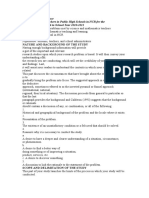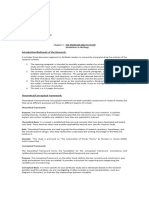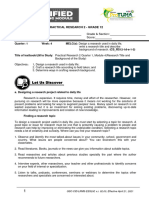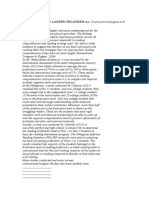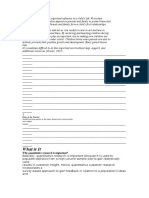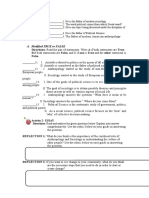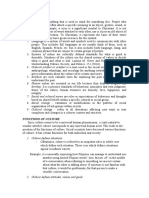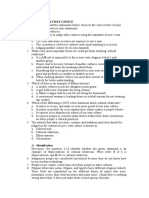0 ratings0% found this document useful (0 votes)
22 viewsProblems Met by Science and Mathematics Teachers in Public High Schools in NCR For The School Year 2005-2006 To School Year 2010-2011
Problems Met by Science and Mathematics Teachers in Public High Schools in NCR For The School Year 2005-2006 To School Year 2010-2011
Uploaded by
Ha KDOGThis document provides background information on a study about problems faced by science and mathematics teachers in public high schools in the National Capital Region of the Philippines from 2005 to 2011. It discusses the need for understanding the context of the research problem and outlines the scope and delimitations of the study, such as focusing on a specific population and geographical area over a seven-year period. The document also provides examples of components that should be included in the background and scope/delimitations sections of a research study.
Copyright:
© All Rights Reserved
Available Formats
Download as PDF, TXT or read online from Scribd
Problems Met by Science and Mathematics Teachers in Public High Schools in NCR For The School Year 2005-2006 To School Year 2010-2011
Problems Met by Science and Mathematics Teachers in Public High Schools in NCR For The School Year 2005-2006 To School Year 2010-2011
Uploaded by
Ha KDOG0 ratings0% found this document useful (0 votes)
22 views4 pagesThis document provides background information on a study about problems faced by science and mathematics teachers in public high schools in the National Capital Region of the Philippines from 2005 to 2011. It discusses the need for understanding the context of the research problem and outlines the scope and delimitations of the study, such as focusing on a specific population and geographical area over a seven-year period. The document also provides examples of components that should be included in the background and scope/delimitations sections of a research study.
Original Description:
Original Title
pract
Copyright
© © All Rights Reserved
Available Formats
PDF, TXT or read online from Scribd
Share this document
Did you find this document useful?
Is this content inappropriate?
This document provides background information on a study about problems faced by science and mathematics teachers in public high schools in the National Capital Region of the Philippines from 2005 to 2011. It discusses the need for understanding the context of the research problem and outlines the scope and delimitations of the study, such as focusing on a specific population and geographical area over a seven-year period. The document also provides examples of components that should be included in the background and scope/delimitations sections of a research study.
Copyright:
© All Rights Reserved
Available Formats
Download as PDF, TXT or read online from Scribd
Download as pdf or txt
0 ratings0% found this document useful (0 votes)
22 views4 pagesProblems Met by Science and Mathematics Teachers in Public High Schools in NCR For The School Year 2005-2006 To School Year 2010-2011
Problems Met by Science and Mathematics Teachers in Public High Schools in NCR For The School Year 2005-2006 To School Year 2010-2011
Uploaded by
Ha KDOGThis document provides background information on a study about problems faced by science and mathematics teachers in public high schools in the National Capital Region of the Philippines from 2005 to 2011. It discusses the need for understanding the context of the research problem and outlines the scope and delimitations of the study, such as focusing on a specific population and geographical area over a seven-year period. The document also provides examples of components that should be included in the background and scope/delimitations sections of a research study.
Copyright:
© All Rights Reserved
Available Formats
Download as PDF, TXT or read online from Scribd
Download as pdf or txt
You are on page 1of 4
Problems Met by Science
and Mathematics Teachers in Public High Schools in NCR for the
School Year 2005-2006 to School Year 2010-2011
Aim: to determine the problems met by science and mathematics teachers
Topic: science and mathematics teaching and learning
Place: public high school in NCR
Period: seven years
Population: students, teachers, and school administrators
NATURE AND BACKGROUND OF THE STUDY
Having enough background information will provide
a gist of the important and relevant
research studies upon which your research problem is based. It will then convey your
understanding of31
the research you are conducting, which will set the credibility of your overall analysis
and findings. Last,
it will assist your readers to understand the contexts in which your research problem is
related.
This part discusses the circumstances that have brought about the study. The purpose
is to
gradually bring the problem into focus. The suggested approach in writing this part is
the deductive
approach, sometimes referred to as the inverted pyramid or funnel approach
(international, national,
regional, then local situation). The discussion proceeds from general to particular so
that the last
paragraph provides the background and Calderon (1993) suggests that the background
or rationale
should contain a discussion of any, or combination, or all of the following:
1.
Historical and geographical background of the problem and the locale where it exists.
2.
Presentation of the problem.
3.
The existence of an unsatisfactory condition or a felt need that should be solved.
4.
Reason/s why it is necessary to conduct the study.
a.
A desire to have a deeper and clearer understanding of a situation, circumstance,
or phenomenon.
b.
A desire to find a better way of
doing something or of improving a situation,
product, services, etc.
c. A desire to discover something.
5.
A discussion to link the rationale to the statement of the problem.
SCOPE AND DELIMITATION OF THE STUDY
This part of your study launches the limits of the process in which your study will be
conducted.
Thus, delimitations are the characteristics that limit the scope and describe the
boundaries of the
study, such as the sample size, geographical location, or setting in which the study
takes place,
population traits, etc. additionally, the researcher might also choose to use some
research tools and
methodologies to collect data but not others. These delimitations might be imposed
for practical reasons
such as lack of time or financial resources to carry out a more thorough investigation.
The delimitation
section of the study should explain why specific choices were made while others were
excluded and how
this might affect the outcome of the research.
In the example mentioned above, the researcher might state why he/she chose to study
a sample
population of 50 students, why he/she selected students from Grades 3-5 and not
Grades 1-2, and why
he/she chose students of Calitlitan Elementary Public School over other schools.
Example:
The study has chosen test anxiety and student’s achievement as variables to be
investigated
through methods of association. One hundred participants from the different colleges
in the university
have to complete survey questions and tests
as a means of gathering the needed data. The study is
expected to be completed in a quarter.
Exercise 1: Multiple Choice. Read the questions carefully. Write the letter of the
BEST answer and on
the space provided before each number.
_________1. This part of chapter 1 includes the objectives of the study. the problem
should be stated
clearly both in general terms and in specific terms.
a. background of the study
b. statement of the problem
c.
significance of the study
d.
scope and limitation32
_________2. An intersting research problem will help:
a. Narrow the scope of research
b. Motivate the author(s)
c.
Save the time
d.
Limit the number of data collection
methods
_________3. Explains the extent to which the research area will be explored in the
work and specifies
the parameters within which the study will be operating.
a. scope
b. delimitation
c.
limitation
d.
research question
_________4. Is this a good academic research topic? "What is the role of advertising
in the world?"
a. No. It is too broad.
b. No It is too narrow
c. Yes. It is a good research topic.
d. No. It is leading.
_________5. These are the characteristics that limit the scope and describe the
boundaries of the study,
such as the sample size, geographical location, or setting in which the study takes
place.
a. limitations
b. delimitations
c. scope
d. assumption
REVISED KNOWLEDGE: Actual answer to the process question/s/ focus
question/s.
1. How to write a good review of literature, a research title, the background of
the study, and
the scope and delimitation of the study?
Many researchers struggle when it comes to writing a literature review for their
research
paper. A literature review is a comprehensive overview of all the knowledge available
on a
specific topic till date. When you decide on a research topic, usually the first step you
take in the
direction of conducting research is to learn more about the previous research
published on the
topic, and this eventually translates into a literature review when you write your
research paper.
Literature review is one of the pillars on which your research idea stands since it
provides
context, relevance, and background to the research problem you are exploring.
FINAL KNOWLEDGE: Generalization/ Synthesis/ Summary
A literature review is a critical summary of all the published works on a particular
topic.
Most research papers include a section on literature review as part of the introduction.
However,
a literature review can also be published as a standalone article. While the basics
would remain
the same for any kind of literature review, whether it is an independent piece of
writing or a part
of a larger article, this post will focus more on literature review as an article type.
Literature reviews, along with systematic reviews and meta-analyses come under the
broad category of review articles. A review article is an overview or critical
assessment of
existing literature in a field, often analyzing specific issues, identifying trends, and
pointing out
research gaps i
You might also like
- Background of The Study-1Document9 pagesBackground of The Study-1Joyae Chavez100% (2)
- Peaceful & Wrathful Deities CommentaryDocument66 pagesPeaceful & Wrathful Deities CommentaryAnn KhakhalovaNo ratings yet
- 100 ITIL Foundation Exam Questions - ITILyaBradyDocument111 pages100 ITIL Foundation Exam Questions - ITILyaBradyAlejandro Garcia AmayaNo ratings yet
- Emotional Intelligence at Work (Dalip Singh) PDFDocument229 pagesEmotional Intelligence at Work (Dalip Singh) PDFVijay100% (5)
- Research Is A Systematic Investigative Process Employed To Increase or Revise Current Knowledge byDocument5 pagesResearch Is A Systematic Investigative Process Employed To Increase or Revise Current Knowledge byJohn Paulo CamachoNo ratings yet
- Scope and DelimDocument3 pagesScope and DelimHa KDOGNo ratings yet
- PR1 Quarter 3 Module 3Document47 pagesPR1 Quarter 3 Module 3justinejoy.acalaNo ratings yet
- PR1 Wlas Q3-W4Document9 pagesPR1 Wlas Q3-W4Ervie AuguisNo ratings yet
- Lesson 2 Research ProblemDocument54 pagesLesson 2 Research ProblemCbrc BulacanNo ratings yet
- Chapter 1Document53 pagesChapter 1Jhastine Mhae De VeraNo ratings yet
- Scope and DelimitationDocument5 pagesScope and DelimitationSam100% (1)
- CotDocument17 pagesCotMARLON APOLINARIONo ratings yet
- Chapter 1-3 Research PaperDocument8 pagesChapter 1-3 Research Paperafnkyarofeepzh100% (1)
- BES 124 Sections of Research PaperDocument9 pagesBES 124 Sections of Research PaperSeira MolinaNo ratings yet
- Practical Research 1 Quarter 1 - Week 4 Identifying The Inquiry and Stating The ProblemDocument8 pagesPractical Research 1 Quarter 1 - Week 4 Identifying The Inquiry and Stating The ProblemJhude JosephNo ratings yet
- Qtr3week2identifying The Problem and Asking The QuestionsDocument47 pagesQtr3week2identifying The Problem and Asking The QuestionsJulie CabusaoNo ratings yet
- PR2 Week4Document5 pagesPR2 Week4Lazabelle BagallonNo ratings yet
- Intro To Research HandoutsDocument10 pagesIntro To Research HandoutsArmiera RamirezNo ratings yet
- Chapter 2 ResearchDocument14 pagesChapter 2 ResearchabibualNo ratings yet
- Research Week 3Document51 pagesResearch Week 3Calizo RussellNo ratings yet
- RequestDocument15 pagesRequestit techNo ratings yet
- English 10 Week 12 13 Fact SheetsDocument4 pagesEnglish 10 Week 12 13 Fact SheetsyvakissNo ratings yet
- BALISA HYLENLY MOR Report Chapter 1 Introduction Statement of Teh Problem HypothesisDocument7 pagesBALISA HYLENLY MOR Report Chapter 1 Introduction Statement of Teh Problem HypothesisJexcel M. CapaningNo ratings yet
- How To Write Chapter 1Document4 pagesHow To Write Chapter 1John Ronald SaldonNo ratings yet
- Learning Module in Practical Research 1: What Is A Research Title?Document5 pagesLearning Module in Practical Research 1: What Is A Research Title?Lyka FrancessNo ratings yet
- Lecture 4Document21 pagesLecture 4Absar BaigNo ratings yet
- Imrad StyleDocument18 pagesImrad Styleezradaan0910No ratings yet
- Background of The ResearchDocument7 pagesBackground of The ResearchCharmaine CantonesNo ratings yet
- Senior Research Project GuidelineDocument9 pagesSenior Research Project GuidelinepinkyNo ratings yet
- Practical Research 1 Module 3Document8 pagesPractical Research 1 Module 3DECA JALUENo ratings yet
- PR1 Module 3Document13 pagesPR1 Module 3denverjayramosNo ratings yet
- The Elements of A Research ProposalDocument10 pagesThe Elements of A Research ProposalHazo FemberaiNo ratings yet
- Prare 2 NotesDocument11 pagesPrare 2 NotesErika DalmaciaNo ratings yet
- IDENTIFYING A RESEARCH PROBLEM Summary'Document14 pagesIDENTIFYING A RESEARCH PROBLEM Summary'NammaNo ratings yet
- Parts of A Research PaperDocument8 pagesParts of A Research Paperdiane ganzaganNo ratings yet
- How To Pose A Research Problem and Type of Research QuestionsDocument13 pagesHow To Pose A Research Problem and Type of Research QuestionsScribdTranslationsNo ratings yet
- PR1 Q1 Modules 10 To 12Document49 pagesPR1 Q1 Modules 10 To 12Rhae Diaz DarisanNo ratings yet
- Practical Research IDocument3 pagesPractical Research Iulol90No ratings yet
- Proposal Guideline-Revised - 2019Document8 pagesProposal Guideline-Revised - 2019Hiwot Melaku GugsaNo ratings yet
- PR1 Reseach Problem and TitleDocument16 pagesPR1 Reseach Problem and TitleKirukaze ItunuzukiNo ratings yet
- Essential Parts of Criminological ResearchDocument11 pagesEssential Parts of Criminological ResearchAngelie Regie EstorqueNo ratings yet
- LAS PR1 WEEK4-4aDocument9 pagesLAS PR1 WEEK4-4aKristine AsuncionNo ratings yet
- Pactical Research 1 M3 4Document45 pagesPactical Research 1 M3 4Ashlee MirasolNo ratings yet
- Research DesignDocument9 pagesResearch DesignIsaac RonoNo ratings yet
- DLI Research Project FormatDocument6 pagesDLI Research Project FormatBusiness HomeNo ratings yet
- ĐỀ CƯƠNG GKDocument5 pagesĐỀ CƯƠNG GKThúy NgaNo ratings yet
- Scope Delimitation SOP Conceptual FrameworkDocument33 pagesScope Delimitation SOP Conceptual FrameworkRemo AngelesNo ratings yet
- Dissertation GuideDocument8 pagesDissertation GuideAwande NdlovuNo ratings yet
- Practical Research 1 - Semifinals - Jan Week 1 To 2Document17 pagesPractical Research 1 - Semifinals - Jan Week 1 To 2Jay DhelNo ratings yet
- How To Write A Research IntroductionDocument12 pagesHow To Write A Research IntroductionJoannaCay GarciaNo ratings yet
- Spist College TitlingDocument53 pagesSpist College TitlingErojem JM A. SerohijosNo ratings yet
- Methods Research ProposalDocument3 pagesMethods Research ProposalMuheed KhanNo ratings yet
- Thesis Guidelines and FormatsDocument7 pagesThesis Guidelines and FormatsMi MiNo ratings yet
- Clean, Well-Thought-Out Proposal Forms The Backbone For The Research Itself and Hence Becomes The Most Important Step in The Process of Conduct of Research. (Document15 pagesClean, Well-Thought-Out Proposal Forms The Backbone For The Research Itself and Hence Becomes The Most Important Step in The Process of Conduct of Research. (Roukia AidNo ratings yet
- PR2 SSLM - Quarter1 - Week4-EvaluatedDocument6 pagesPR2 SSLM - Quarter1 - Week4-EvaluatedROSEMARIE BAYHONNo ratings yet
- Thesis WritingDocument5 pagesThesis Writingr.c.nudz3998100% (1)
- PR 1 Week 3 and Week 4Document6 pagesPR 1 Week 3 and Week 4Jaja CabaticNo ratings yet
- LAS InquiriesDocument17 pagesLAS InquiriesCristine Elizabeth OritaNo ratings yet
- Senior Research Project FrameworkDocument10 pagesSenior Research Project FrameworkAndualem ZenebeNo ratings yet
- PRACTICAL RESEARCH 2 Identifying The Inquiry and Stating The ProblemDocument17 pagesPRACTICAL RESEARCH 2 Identifying The Inquiry and Stating The ProblemBryan AtacadorNo ratings yet
- Week 2 AssignmentDocument2 pagesWeek 2 Assignmentsinta muchlisNo ratings yet
- Writing Research Proposal: BY Dr. Robert MugabeDocument49 pagesWriting Research Proposal: BY Dr. Robert MugabeBanolka NobNo ratings yet
- How to Write a Dissertation: An Instructional Manual for Dissertation Writers.From EverandHow to Write a Dissertation: An Instructional Manual for Dissertation Writers.No ratings yet
- First Quarter Module: Introduction!Document48 pagesFirst Quarter Module: Introduction!Ha KDOG100% (1)
- For Exercise 2, W Rite Your Answers in This LADDER ORGANIZERDocument5 pagesFor Exercise 2, W Rite Your Answers in This LADDER ORGANIZERHa KDOGNo ratings yet
- This Study Resource Was: Week 3 Activity 2: EssayDocument3 pagesThis Study Resource Was: Week 3 Activity 2: EssayHa KDOG100% (1)
- Literature Reviewer D Urbz PDFDocument18 pagesLiterature Reviewer D Urbz PDFHa KDOGNo ratings yet
- Hypothesis - Testing General MathDocument20 pagesHypothesis - Testing General MathHa KDOGNo ratings yet
- Kambas NG LipunasbnmDocument1 pageKambas NG LipunasbnmHa KDOGNo ratings yet
- This Study Resource Was: Religious Education 3Document8 pagesThis Study Resource Was: Religious Education 3Ha KDOGNo ratings yet
- Day 1 Problems Involving Inverse Functions: ExercisesDocument12 pagesDay 1 Problems Involving Inverse Functions: ExercisesHa KDOGNo ratings yet
- Family Is The Single Most Important Influence in ADocument3 pagesFamily Is The Single Most Important Influence in AHa KDOGNo ratings yet
- Background Information For LearnersDocument6 pagesBackground Information For LearnersHa KDOGNo ratings yet
- Saint Louis School of Solano, Inc.: Self-Paced Learning Module 21 Century Literature From The PhilippinesDocument74 pagesSaint Louis School of Solano, Inc.: Self-Paced Learning Module 21 Century Literature From The PhilippinesHa KDOGNo ratings yet
- Writing A Research Title: Aim (Purpose) - It Answers The Question, "Why Do I Want To Conduct This Study?" ADocument2 pagesWriting A Research Title: Aim (Purpose) - It Answers The Question, "Why Do I Want To Conduct This Study?" AHa KDOGNo ratings yet
- Directions: Column B Consists of Scrambled Words. Form The Correct Words andDocument2 pagesDirections: Column B Consists of Scrambled Words. Form The Correct Words andHa KDOGNo ratings yet
- Exploration of Prior KnowledgeDocument3 pagesExploration of Prior KnowledgeHa KDOGNo ratings yet
- Problems Met by ScienceDocument1 pageProblems Met by ScienceHa KDOGNo ratings yet
- A. Modified TRUE or FALSE: Activity 2: ESSAY Directions: Read and Analyse The Given Questions Below. Explain Your AnswerDocument1 pageA. Modified TRUE or FALSE: Activity 2: ESSAY Directions: Read and Analyse The Given Questions Below. Explain Your AnswerHa KDOGNo ratings yet
- Remember!: Functions of Culture Since Culture Seems To Be A Universal Human Phenomenon, Is Only Natural ToDocument2 pagesRemember!: Functions of Culture Since Culture Seems To Be A Universal Human Phenomenon, Is Only Natural ToHa KDOGNo ratings yet
- Directions: Read The Statements Below. Encircle The Correct Letter of YourDocument2 pagesDirections: Read The Statements Below. Encircle The Correct Letter of YourHa KDOGNo ratings yet
- You Should Be Able To Answer Them at The End of THDocument4 pagesYou Should Be Able To Answer Them at The End of THHa KDOGNo ratings yet
- Directions:: Criteria 5 4 2 1Document3 pagesDirections:: Criteria 5 4 2 1Ha KDOGNo ratings yet
- Formulario de Cálculo Diferencial e Integral: Jesús Rubí Miranda (Document2 pagesFormulario de Cálculo Diferencial e Integral: Jesús Rubí Miranda (lagarto27No ratings yet
- 2016 - 08 - 29-IPQ - Center - Cheat Sheet - ICMDocument5 pages2016 - 08 - 29-IPQ - Center - Cheat Sheet - ICMHamid KharazmiNo ratings yet
- Guidance and ControlDocument68 pagesGuidance and ControldeepsoulNo ratings yet
- Writing Arguments: Key Learning ObjectiveDocument9 pagesWriting Arguments: Key Learning ObjectiveSayed MikoNo ratings yet
- Chennai Institute of Technology: Department of Civil EngineeringDocument28 pagesChennai Institute of Technology: Department of Civil EngineeringEdifice Placement SolutionsNo ratings yet
- Examination Session 2021-22 B.A. (NEP) - YEAR-1-SEM-2 (U.G. (NEP) Semester (Regular) Even)Document2 pagesExamination Session 2021-22 B.A. (NEP) - YEAR-1-SEM-2 (U.G. (NEP) Semester (Regular) Even)Sandeep KumarNo ratings yet
- Medical IllustrationDocument26 pagesMedical IllustrationPurny Eiffel GezzNo ratings yet
- Torben Overgaard Vs Godwin Valdez PDFDocument2 pagesTorben Overgaard Vs Godwin Valdez PDFqwertyNo ratings yet
- Government of The Virgin Islands v. Charles Leonard, 548 F.2d 478, 3rd Cir. (1977)Document5 pagesGovernment of The Virgin Islands v. Charles Leonard, 548 F.2d 478, 3rd Cir. (1977)Scribd Government DocsNo ratings yet
- The Hidden Meaning of Water-Cement Ratio: Distance Between Cement Particles Is FundamentalDocument0 pagesThe Hidden Meaning of Water-Cement Ratio: Distance Between Cement Particles Is Fundamentalmahreza189No ratings yet
- Use of Alcohol in ProductsDocument15 pagesUse of Alcohol in ProductsCHE WAN MUHAMMAD FAIZ CHE WAN ABDULLAHNo ratings yet
- Hinabangan National High School: A. Classroom Preparation/ManagementDocument2 pagesHinabangan National High School: A. Classroom Preparation/ManagementApril Marjorie Bacaycay Cardenas - DacanayNo ratings yet
- Jesus and The Celibate PriesthoodDocument4 pagesJesus and The Celibate PriesthoodDavidNo ratings yet
- Lesson Plan Template 6Document3 pagesLesson Plan Template 6api-241116553No ratings yet
- Constitutional Provisions For SCDocument3 pagesConstitutional Provisions For SCGaurav PrabhakerNo ratings yet
- Контрольные задания к Enjoy English 2-4 классыDocument36 pagesКонтрольные задания к Enjoy English 2-4 классыАнастасия Токарева100% (1)
- Icic BankDocument29 pagesIcic Bankjassi7nishadNo ratings yet
- Organizational Ambidexterity and Competitive Advantage The Role ofDocument11 pagesOrganizational Ambidexterity and Competitive Advantage The Role ofPangeran Henrajostanhidajat SastrawidjajaNo ratings yet
- A. Modification of The Conditions of DiversionDocument4 pagesA. Modification of The Conditions of DiversionRoann RemolanoNo ratings yet
- MY STORY For PrintDocument31 pagesMY STORY For PrintARLENE SENANo ratings yet
- Suggestion 2Document8 pagesSuggestion 2Adellya PutriNo ratings yet
- Maternity Nursing Lecture NotesDocument198 pagesMaternity Nursing Lecture Notesprogramgrabber75% (4)
- A Dictionary Path 00 Bran GoogDocument252 pagesA Dictionary Path 00 Bran GoogdineshdineshdineshNo ratings yet
- Glosario de Términos de Seguros - L. SoléDocument15 pagesGlosario de Términos de Seguros - L. SoléNancyBANo ratings yet
- Internship ReportDocument37 pagesInternship Reportkhursheed6686% (29)
- Cool Dynamic Business PowerPoint TemplatesDocument35 pagesCool Dynamic Business PowerPoint TemplatesJenny Rose MagandamNo ratings yet
- FBC vs. AbcDocument6 pagesFBC vs. AbcAnum NaeemNo ratings yet





